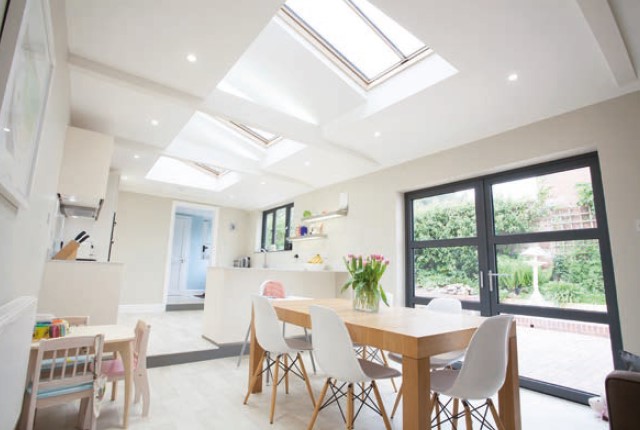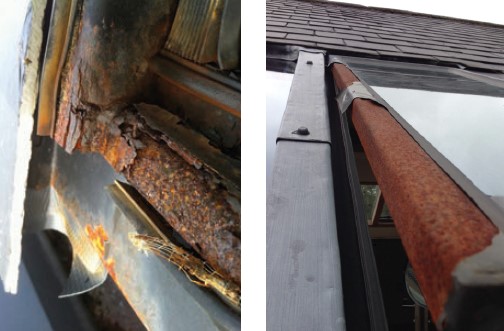Steel framed rooflights
Contents |
[edit] Introduction
It is widely acknowledged by both professionals and consumers that steel is the premier choice for conservation rooflights. Able to achieve great strength while retaining a thin framework and a low profile finish, steel framed rooflights provide an appearance that modern alternatives can only dream of replicating.
[edit] Characteristics of steel framed rooflights
Commonly specified in both period and contemporary projects, a steel framed rooflight design normally offers a superior glass to frame ratio when compared with modern bulky rooflights. This extra access to both natural light and ventilation is one of the reasons why steel frames remain a popular choice.
In certain applications, such as listed buildings, conservation areas or sensitive replacements, steel framed rooflights should be the only choice, as these offer the most faithful replica of an original Victorian design. The saying goes that ‘beauty is only skin deep’, however, when choosing or specifying rooflights, it is important that you look beyond appearance and take into consideration the longevity and maintenance requirements of the materials used.
[edit] Aren’t all steel rooflights the same?
While the appearance of a steel framed rooflight is second to none, there is an inherent shortcoming in the use of steel, particularly when used in a roof, and that is the potential for it to rust. The most common steel used for conservation rooflights is mild steel because of its relatively low price and versatility. Mild steel is made from iron containing a small percentage of carbon, which makes it strong and tough but not readily tempered.
In its naked form, mild steel (sometimes referred to as plain-carbon or low-carbon steel) offers virtually no resistance against rusting and will begin to corrode from the moment it comes into contact with the atmosphere. Almost all rooflights are produced with some type of paint coating designed to keep the main structure away from atmospheric conditions; in the case of mild steel rooflights this prevents them from rusting. It is worth noting that mild steel framed rooflights are totally dependent on paint to stop the frames rusting. Even the slightest damage during installation can signal the demise of your rooflight.
One of the ways to avoid the risk of rusting associated with steel framed rooflights is to specify a 316 marine grade stainless frame. The most obvious difference between carbon steel and stainless steel is the ability to resist corrosion, with stainless steel (as the name implies) being the more corrosion resistant material.
Both carbon steel and stainless steel contain iron, which oxidizes when exposed to the environment and produces rust. It is the presence of added chromium in stainless steel that makes it more corrosion resistant than carbon steel. Without wishing to overcomplicate the point, the chromium will attach itself to oxygen more readily than iron, but when the chromium attaches to the oxygen it creates a chromium oxide layer, which protects the rest of the material from degradation and corrosion.
Carbon steel does not have enough chromium to form this chromium oxide layer, allowing oxygen to bond with the iron and result in iron oxide or rust. Therefore, if corrosion resistance is a key factor in your choice of specification, stainless steel has to be the way to go.
[edit] Protective coatings
Steel framed rooflights will usually have a powder coated finish, since this offers a better final appearance than wet spray alternatives. Powder coat is a type of coating that is applied as a free-flowing, dry powder. Unlike most conventional liquid paints, which are applied via an evaporating solvent, powder coating is typically applied electrostatically and then cured under heat. Applied to the right environment criteria, powder coated rooflights are more resistant to diminished coating quality as a result of impact, moisture, ultraviolet light and other extreme weather conditions.
Powder coating is mainly used for coating metals and is designed to create a finish that is tougher than conventional paint. Unlike mild steel, which relies on the coating for complete protection, a 316 marine grade stainless steel rooflight mainly has the coating for aesthetic purposes. When correctly applied, powder coating provides a high quality finish which gives metalwork a more durable layer than liquid paints can offer while still providing an attractive appearance.
Powder coat applications should always be applied to a standard suitable for the location of the rooflight. The environment in which a rooflight is located is classified from C1 to C5, with the lower end of the scale (C1) for internal use in buildings with clean atmospheres, right up to marine coastal/industrial with aggressive atmosphere (C5).
The most common application for steel framed rooflights is to a C3 standard, which covers urban and industrial atmospheres with moderate sulphur dioxide pollution. While this should give a good standard of protection for most places in the UK, there are a number of factors that could modify the lifespan but are often overlooked.
It is easy to identify a property which is within 5km of the coast and specify the required marine coating, however if a property is located close to a road which is heavily gritted during the winter months this could potentially be as aggressive and corrosive to the powder coating as a property which is sited within a coastal environment. Ultimately, identifying the right classification is not always as straightforward as looking up a postcode. Careful consideration should be given to any environmental factors that may impact on the lifespan of the protective coating. Choosing the right durability is a question of cost, but if the system doesn’t last long enough, rectification could be expensive for the end user.
[edit] Paint coats are not magic coats!
Industrial coatings are no different to the paint on your car - they need cleaning and maintaining. Accumulated dirt may affect the design life of the system, and any mechanical damage almost certainly will. Therefore, regular inspections should take place and minor damage must be touched up.
What many specifiers and end users do not appreciate is that maintenance is not only required to keep up the aesthetic appearance, it is essential to prolong the life of the rooflight. From the moment the product is installed, the end user is entirely responsible for providing that maintenance. Failure to do so is likely to render any warranty void. The care and maintenance of a rooflight situated in a C3 environment is likely to be recommended on an annual basis, but this can increase to every three months in a coastal C4 location.
One of the biggest causes of steel rooflights rusting is a failure to adhere to maintenance guidelines, either due their inaccessible location or an unwillingness to undertake the work by the end user. In fact, it is often only when the rooflight is leaking that action is taken, and in most cases, this is far too late to save the rooflight from a level of degradation that renders the product unsafe or no longer functional. It is normally at this point where the homeowner is told that the warranty is void and the problem is theirs to deal with.
With a mild steel rooflight, it is essential that the specifier and end user are fully aware of what is required to extend the product life. All rooflight companies will issue guarantee and maintenance paperwork with their products, and most go to great lengths to publish the information on their websites. However, it is not uncommon for that information to be overlooked or lost and only returned to long after the time for maintenance has passed.
It is not just coastal rooflights that benefit from the longevity offered by stainless steel. If the rooflights are to be fitted in an inaccessible location, or the end user is unlikely to head out with a ladder and a bucket of soapy water on a regular basis, then 316 marine grade stainless should be the first choice.
There is no getting away from the initial price uplift of stainless in comparison to mild steel, but without the overhead of repair or replacement, the whole life cost of stainless can be considerably less than the lower quality alternatives.
[edit] In summary
If you are intending to specify steel framed rooflights, be it for either a traditional or contemporary project, then the advice would be to give greater consideration to the type of steel rather than just the appearance. You need to consider the location of the property, further than simply its proximity to the coast, and whether there are any factors that may adversely affect the coating life. You should also make your clients aware of their responsibilities to undertake the maintenance and check with your chosen supplier as to what level of care is likely to be required.
With some leading rooflight companies only offering a standard 12 month warranty on their products and always having the strict maintenance requirements to fall back on, you may want to simply consider designing out any potential issues by specifying 316 marine grade stainless from the outset. While all rooflights and all paint coatings will require some level of care, a stainless option will not suffer the same catastrophic material failure as a mild steel rooflight should your client not keep up with the maintenance.
This article originally appeared in the Architectural Technology Journal (at) issue 134 published by CIAT in Summer 2020 under the headline, 'Steel framed rooflights – what lies beneath?' It was written by Paul Trace, Stella Rooflight.
--CIAT
[edit] Related articles on Designing Buildings Wiki
Featured articles and news
RTPI leader to become new CIOB Chief Executive Officer
Dr Victoria Hills MRTPI, FICE to take over after Caroline Gumble’s departure.
Social and affordable housing, a long term plan for delivery
The “Delivering a Decade of Renewal for Social and Affordable Housing” strategy sets out future path.
A change to adoptive architecture
Effects of global weather warming on architectural detailing, material choice and human interaction.
The proposed publicly owned and backed subsidiary of Homes England, to facilitate new homes.
How big is the problem and what can we do to mitigate the effects?
Overheating guidance and tools for building designers
A number of cool guides to help with the heat.
The UK's Modern Industrial Strategy: A 10 year plan
Previous consultation criticism, current key elements and general support with some persisting reservations.
Building Safety Regulator reforms
New roles, new staff and a new fast track service pave the way for a single construction regulator.
Architectural Technologist CPDs and Communications
CIAT CPD… and how you can do it!
Cooling centres and cool spaces
Managing extreme heat in cities by directing the public to places for heat stress relief and water sources.
Winter gardens: A brief history and warm variations
Extending the season with glass in different forms and terms.
Restoring Great Yarmouth's Winter Gardens
Transforming one of the least sustainable constructions imaginable.
Construction Skills Mission Board launch sector drive
Newly formed government and industry collaboration set strategy for recruiting an additional 100,000 construction workers a year.
New Architects Code comes into effect in September 2025
ARB Architects Code of Conduct and Practice available with ongoing consultation regarding guidance.
Welsh Skills Body (Medr) launches ambitious plan
The new skills body brings together funding and regulation of tertiary education and research for the devolved nation.
Paul Gandy FCIOB announced as next CIOB President
Former Tilbury Douglas CEO takes helm.
UK Infrastructure: A 10 Year Strategy. In brief with reactions
With the National Infrastructure and Service Transformation Authority (NISTA).

























